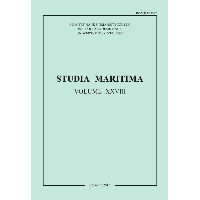Tranzyt czechosłowacki w portach ujścia Odry po II wojnie światowej
The Checkoslovakian Transit through the Ports of the Oder Estuary after World War 2
Author(s): Ryszard TechmanSubject(s): Economic history, Recent History (1900 till today), Economic policy, International relations/trade, Financial Markets
Published by: Wydawnictwo Naukowe Uniwersytetu Szczecińskiego
Keywords: contacts between Poland and Czechoslovakia; the transit of Czechoslovakian goods through the port of Szczecin; the period of the Polish People’s Republic (1945–1989);
Summary/Abstract: For the Republic of Chechoslovakia, a state without access to the sea, a natural way to get to the Baltic Sea was the Oder and Szczecin (Stettin). Between the two World Wars in the 20th century the country on the Wlatava (German: Moldau), in spite of receiving its own duty-free zone in the Szczecin port and in spite of its own river barges according to the treaty of Versailles, did not take the full advantage of the Oder route. A series of events caused that Prague directed its trade and transit expansion towards the ports of the North Sea, especially Hamburg, and the Mediterranean Sea. The second world war brought about some political and economic changes in the situation of Poland and Checkoslovakia. As a result of the territorial changes a part of the German territories, including most of the course of the Oder, became Polish. Any potential border conflict between the two countries was prevented by signing the treaty of friendship and mutual assistance on March 10th, 1947, and on July 4th of the same year – a convention of economic cooperation. An important part of the latter was the chapter concerning the transit arrangements, thanks to which Czechoslovakia was conceded a duty-free zone in the Szczecin port and a privileged position in the navigation on the Oder; the convention entitled the Czechoslovakian merchant shipping to use the Polish seaports on the same conditions the Polish ships had. A consequence of the transit arrangements was an agreement between Czechoslovakia and Poland concerning the lease of a part of the Szczecin port concluded on July 15th, 1949. By virtue of that agreement Czechoslovakia received a wharf 300 metres long and 100 metres wide for its own use. May 12th, 1948 saw the creation of the Czechoslovakian Oder Navigation (Company) to run the navigation on the Oder River by the Czechoslovakian barges; its headquarters were in Wrocław with a branch in Szczecin. On the other hand, at the end of the 1940s the Czechoslovakian freight forwarding passing through the Polish ports was monopolised by the PLC ‘Spedrapid’ in Gdynia (with branches in Gdańsk and Szczecin); its capital and management were partly Polish and partly Czechoslovakian. After a few years of using its own wharf in the Szczecin port and operating the shipping company on the Oder (both of which turned out to be extremely unprofitable) Czechoslovakia gave them up. A new agreement between Poland and Czechoslovakia was concluded on January 13th, 1956; it put an end to the foreign area in the port of Szczecin and to the shipping company on the Oder. Surprisingly, the liquidation of the two agencies did not result in a decrease of transit turnover but just the reverse: caused its increase. In the subsequent decades Szczecin played an important role in the Czechoslovakian foreign trade. In 1958 Szczecin became the biggest transit port for our southern neighbour overtaking Hamburg. The Szczecin shipowner – the Polish Steamship Company – was one of the leading carriers in the Czechoslovakian exports and imports. Czechoslovakia purchased products of the Polish shipyards, whence a part of its ships came. A significant part of the officers of the Czechoslovakian Shipping Company (Československá námořní plavba) had been prepared by the Maritime Academy in Szczecin. Yet, the attempts to cooperate more closely undertaken in the 1960s, 1970s and 1980s failed.
Journal: Studia Maritima
- Issue Year: 28/2015
- Issue No: 1
- Page Range: 229-274
- Page Count: 46
- Language: Polish

